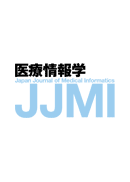All issues

Volume 34 (2014)
- Issue 6 Pages 257-
- Issue 5 Pages 211-
- Issue 4 Pages 159-
- Issue 3 Pages 101-
- Issue 2 Pages 55-
- Issue 1 Pages 3-
Volume 34, Issue 6
Displaying 1-4 of 4 articles from this issue
- |<
- <
- 1
- >
- >|
Original Article-Notes
-
H Tsukuma, T Tanaka, M Ikeuchi2014Volume 34Issue 6 Pages 257-269
Published: 2014
Released on J-STAGE: April 20, 2016
JOURNAL FREE ACCESS[Aim] For the research and development of the hospital information system (HIS), an evaluation report on effectiveness of the HIS in each facility is one of the important resources. In reference to the IS guideline, bibliographic investigation is conducted in order to grasp the present situation of the effectiveness evaluation of HIS. [Method] Being based on the IS guideline, the six checkpoints which should be described in the article on the effectiveness evaluation of HIS was arranged. Among the articles of the Joint Conference of Medical Informatics (JCMI) of 2010-2012, the articles indicated “system” and “evaluation” in the title were extracted, and the six checkpoints were investigated. [Result] 53 articles were extracted, and 23 articles except 30 which were not related to a HIS were investigated. Many articles had problems about the six checkpoints. [Discussion] The result suggested a necessity for a guideline about how to write more effectively on evaluation of HIS.View full abstractDownload PDF (1540K) -
T Nishimura, T Nagao, H Iseki, Y Muragaki, M Tamura, S Minami2014Volume 34Issue 6 Pages 271-279
Published: 2014
Released on J-STAGE: April 20, 2016
JOURNAL FREE ACCESSMedical technology has been highly developed, however advanced medical technique depends on expert surgeons. In our study, we aim to analyze surgeon’s knowledge and judgment process from surgical video records. In general, surgical video records are objective data, so they are widely used for such as detection of important scene and knowledge discovery. However, the length of surgical video records is more than 10 hours, so automatic tagging method is required for detecting such as significant scene and occurred events labeling.
In this paper, we propose automatic tagging using audio information for awake craniotomy videos recorded in Tokyo Women’s Medical University Hospital. The timing of electrical stimulation for brain cortex is tagged from recorded sound. After that, we construct speaker model by Gaussian Mixture Model (GMM) and to index speaker from surgery sounds. In the experiments, we validated electrical stimulation timing detection and speaker labeling. The results show that awake craniotomy videos are able to tag by audio information.View full abstractDownload PDF (1241K)
Interest Material
-
M Tagi, Y Tamaki, T Morikawa, M Matsuhisa, H Moriguchi2014Volume 34Issue 6 Pages 281-291
Published: 2014
Released on J-STAGE: April 20, 2016
JOURNAL FREE ACCESSTo record individual body weight and physical activity has been shown to be beneficial for maintaining personal health. We, therefore, established a system which connects a personal computer and health appliances to record body weight, daily step, and blood pressure. We applied this system to 226 employees in 3 companies during the period of October, 2011-March, 2013 and evaluated whether this system could improve individual behavioral modification. One hundred sixty seven persons (73.9%) had continuously recorded the measurement of the pedometer for at least one year. We compared the average of the first three months with the average of the next three months. As a result, the number of steps tended to increase to 7,515±4,629 steps from 7,299±3,731steps (p=0.075). As for blood pressure, the systolic phase significantly decreased from 129.2±13.2 mmHg to 127.1±13.5 mmHg (p=0.028), and diastolic phase decreased from 78.6±9.8 mmHg to 76.0±9.9 mmHg (p=0.00016). BMI also significantly decreased from 23.3±2.9 kg/m2 to 23.2±2.8 kg/m2(p=0.029). In conclusion, to record daily step, body weight and blood pressure by using newly established system improved individual behavior towards a healthy condition.View full abstractDownload PDF (1353K) -
M Seki, H Tsubaki2014Volume 34Issue 6 Pages 293-304
Published: 2014
Released on J-STAGE: April 20, 2016
JOURNAL FREE ACCESSDevelopment of community-wide medical collaboration has been enabling for community pharmacies to check patient’s prescriptions with medical records and pharmacy claims. To our knowledge, however, there have been little studies showing the need for such a collaboration with factual data. We therefore conducted a drug utilization study investigating the prevalence of potential drug-drug interactions using the national database of health insurance claim information, provided by the Ministry of Health, Labour and Welfare.
Of the number of 755,247 outpatient claims, 543,506 (72.0%) patients had their prescription filled at a community pharmacy. Of 431,873 patients with concomitant use of oral drugs, the number of those who were administered a drug combination with caution for concomitant use, a combination with extreme caution for concomitant use and a contraindicated combination according to product’s labels were 204,067 (47.3%), 946 (0.2%) and 275 (0.1%) respectively. The frequency of patients administered a drug combination with caution for concomitant use increased with age, and the most frequent agents involved in these combinations were cardiovascular agents, antidiabetics, and agents affecting central nervous system. Lipid-regulating drugs was the only drugs involved in extreme caution for concomitant use, and antimigraine drugs, drugs including metal irons, antifungals, macrolides, and immunosuppressants were the most frequent drugs involved in a contraindicated combination, along with cardiovascular agents and agents affecting central nervous system.
As to a contraindicated drug combination between medical claims and pharmacy claims, many drugs in these combinations were indicated for different diagnosis from the other drugs.
Considering that the majority of outpatients had their prescriptions filled in a community pharmacy, there is a real need for the development of a community-wide medical collaboration.View full abstractDownload PDF (735K)
- |<
- <
- 1
- >
- >|